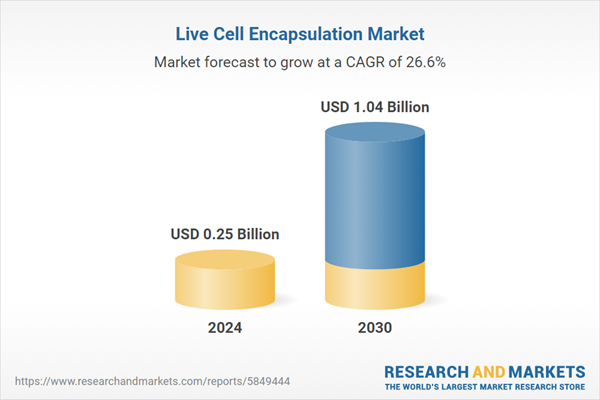Speak directly to the analyst to clarify any post sales queries you may have.
10% Free customizationThis report comes with 10% free customization, enabling you to add data that meets your specific business needs.
Moreover, live cell encapsulation is found to have significant importance in cell therapies as it allows a controlled release of bioactive material or cells and thereby is anticipated to bolster market growth with rise in cell therapies across the globe.
Key Market Drivers
Increasing Incidence of Chronic Diseases Requiring Cell-Based Therapies
One of the primary drivers fueling the live cell encapsulation market is the rising prevalence of chronic and non-communicable diseases (NCDs) such as diabetes, cancer, and neurological disorders. Encapsulation technology allows for the delivery of therapeutic cells, such as pancreatic islet cells, which are crucial for insulin production in type 1 diabetes. According to the World Health Organization (WHO), NCDs are responsible for over 74% of all global deaths, and nearly 422 million people globally have diabetes. A significant portion of this population requires lifelong insulin therapy, and live cell encapsulation offers a transformative solution through potential curative therapies.The ability of encapsulated cells to provide sustained therapeutic benefit without provoking an immune response has made this technique increasingly important for regenerative medicine. Governments in high-burden countries have begun investing in regenerative medicine research. For example, the U.S. National Institutes of Health (NIH) allocated nearly $2 billion toward cell-based therapy and regenerative medicine research in recent years. Similarly, the European Commission supports cell-based innovation through its Horizon Europe program. These investments indicate growing public sector endorsement for technologies like cell encapsulation, particularly in chronic disease management.
Key Market Challenges
Immune Rejection and Fibrotic Overgrowth
Despite technological progress, one of the most persistent challenges in the live cell encapsulation market is immune rejection and fibrotic response that can limit the functional lifespan of encapsulated cells. While the encapsulation membrane is designed to shield cells from immune surveillance, over time the body may still recognize the foreign material and initiate fibrotic encapsulation, which leads to reduced nutrient exchange and eventual cell death.This issue is particularly problematic in long-term applications such as pancreatic islet transplantation for diabetes or encapsulated neural cells for treating Parkinson’s disease. According to the National Institute of Diabetes and Digestive and Kidney Diseases (NIDDK), clinical studies of islet transplantation show promising early results but often experience a decline in cell function over time due to immune-mediated encapsulation or fibrosis. This has limited the wide-scale clinical adoption of encapsulated cell therapies, especially in countries with stringent medical device approval processes.
Key Market Trends
Rising Use of Encapsulation in Regenerative Medicine and Tissue Engineering
A significant trend shaping the live cell encapsulation market is its expanding role in regenerative medicine and tissue engineering applications. Researchers are increasingly using encapsulated cells not only for drug delivery but also to repair or regenerate damaged tissues, including cartilage, cardiac muscle, and neuronal structures. The biocompatibility and immune-isolating properties of encapsulated cells make them highly suitable for transplantation in environments where immune rejection is a concern.Governmental support for regenerative medicine is growing globally. For example, the U.S. 21st Century Cures Act allocates billions toward advancing regenerative therapies, and the European Union’s Horizon Europe program continues to fund cross-border collaborative research in tissue regeneration. Encapsulation plays a central role in these initiatives, offering controlled, localized cell delivery and minimizing systemic side effects.
Key Market Players
- Merck KGaA
- Sphere Bio.
- Vertex Pharmaceuticals Incorporated
- Unchained Labs.
- BIO INX
- Algorae Pharmaceuticals Ltd
- Eli Lilly and Company
- Isogen Lifescience B.V.
- Diatranz Otsuka Ltd
- PHAXIAM Therapeutics S.A.
Report Scope:
In this report, the Global Live Cell Encapsulation Market has been segmented into the following categories, in addition to the industry trends which have also been detailed below:Live Cell Encapsulation Market, By Polymer Type:
- Alginate
- Chitosan
- Cellulose Sulfate
- Others
Live Cell Encapsulation Market, By Application:
- Drug Delivery
- Regenerative Medicine
- Cell Transplantation
- Probiotics
Live Cell Encapsulation Market, By Technique:
- Simple Dripping
- Electrostatic Dripping
- Coaxial Airflow
Live Cell Encapsulation Market, By Region:
- North America
- United States
- Mexico
- Canada
- Europe
- France
- Germany
- United Kingdom
- Italy
- Spain
- Asia-Pacific
- China
- India
- South Korea
- Japan
- Australia
- South America
- Brazil
- Argentina
- Colombia
- Middle East and Africa
- South Africa
- Saudi Arabia
- UAE
Competitive Landscape
Company Profiles: Detailed analysis of the major companies present in the Global Live Cell Encapsulation Market.Available Customizations:
With the given market data, the publisher offers customizations according to a company's specific needs. The following customization options are available for the report.Company Information
- Detailed analysis and profiling of additional market players (up to five).
This product will be delivered within 1-3 business days.
Table of Contents
Companies Mentioned
- Merck KGaA
- Sphere Bio.
- Vertex Pharmaceuticals Incorporated
- Unchained Labs.
- BIO INX
- Algorae Pharmaceuticals Ltd
- Eli Lilly and Company
- Isogen Lifescience B.V.
- Diatranz Otsuka Ltd
- PHAXIAM Therapeutics S.A.
Table Information
| Report Attribute | Details |
|---|---|
| No. of Pages | 180 |
| Published | July 2025 |
| Forecast Period | 2024 - 2030 |
| Estimated Market Value ( USD | $ 0.25 Billion |
| Forecasted Market Value ( USD | $ 1.04 Billion |
| Compound Annual Growth Rate | 26.6% |
| Regions Covered | Global |
| No. of Companies Mentioned | 10 |









